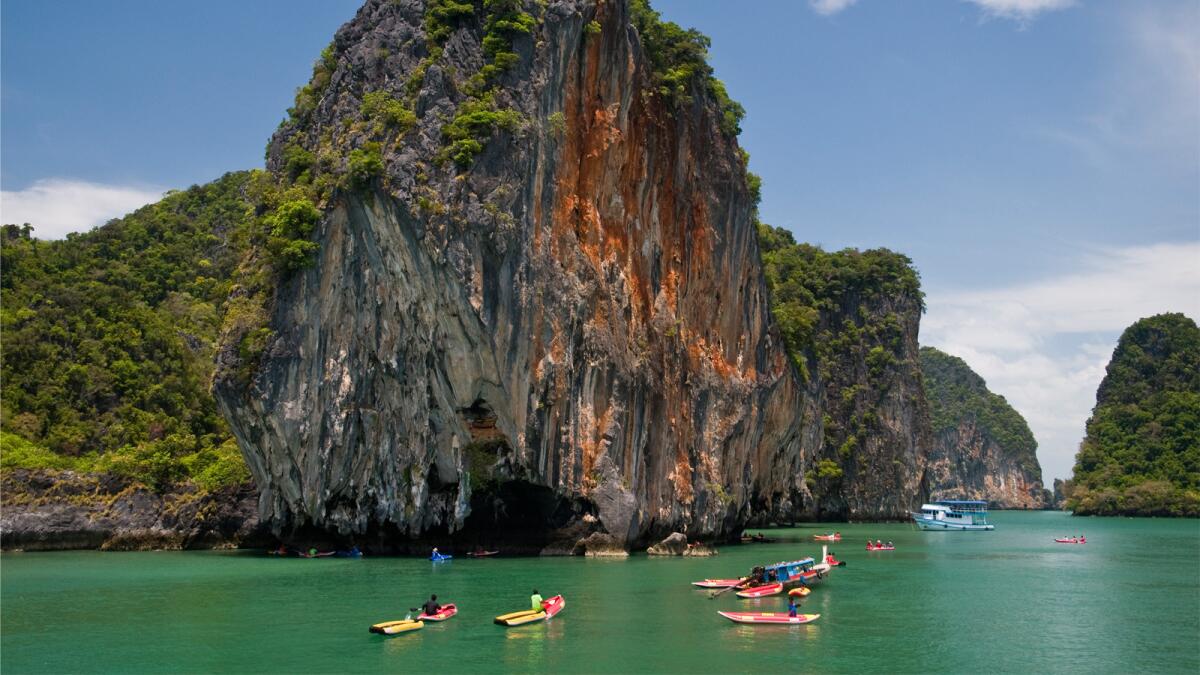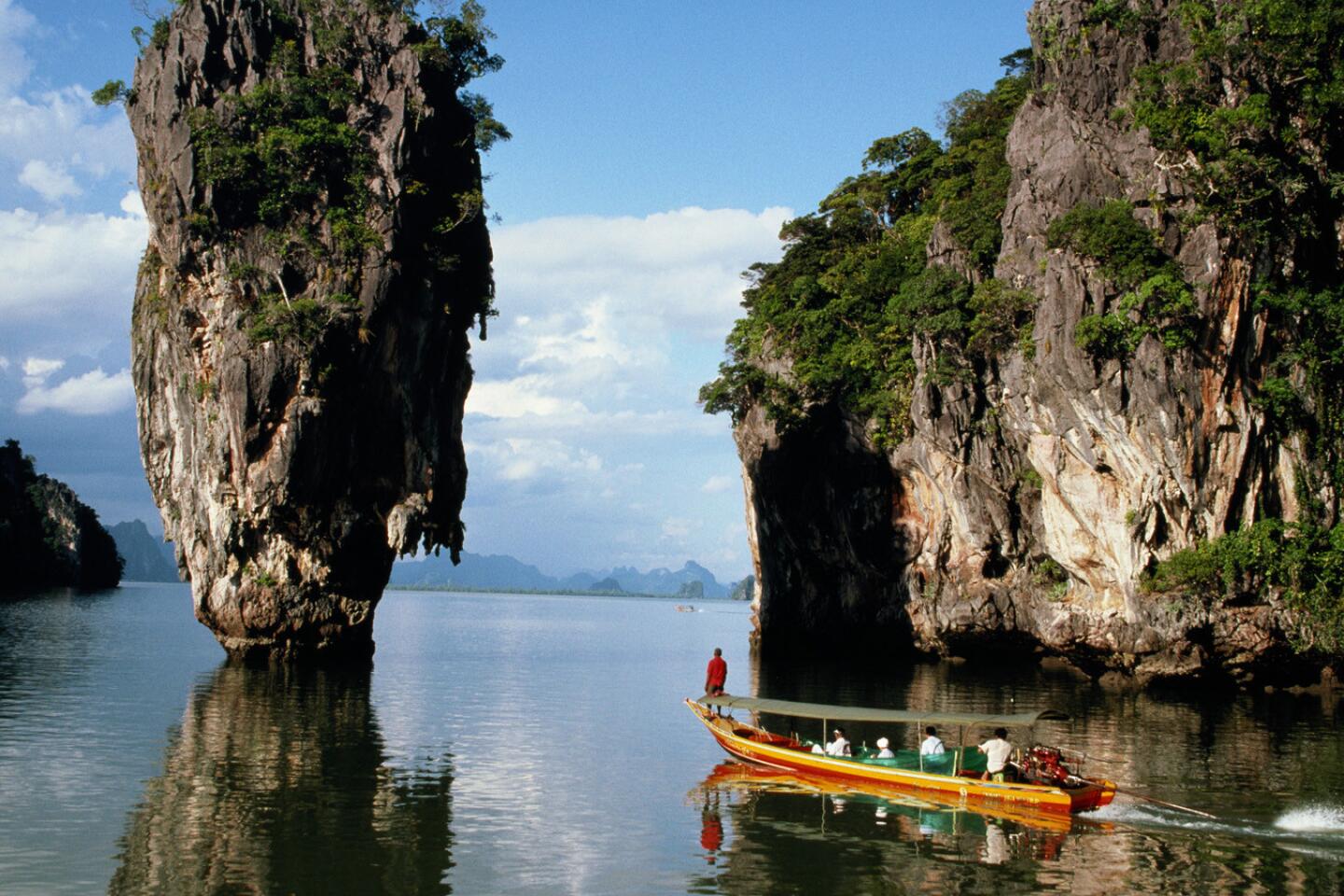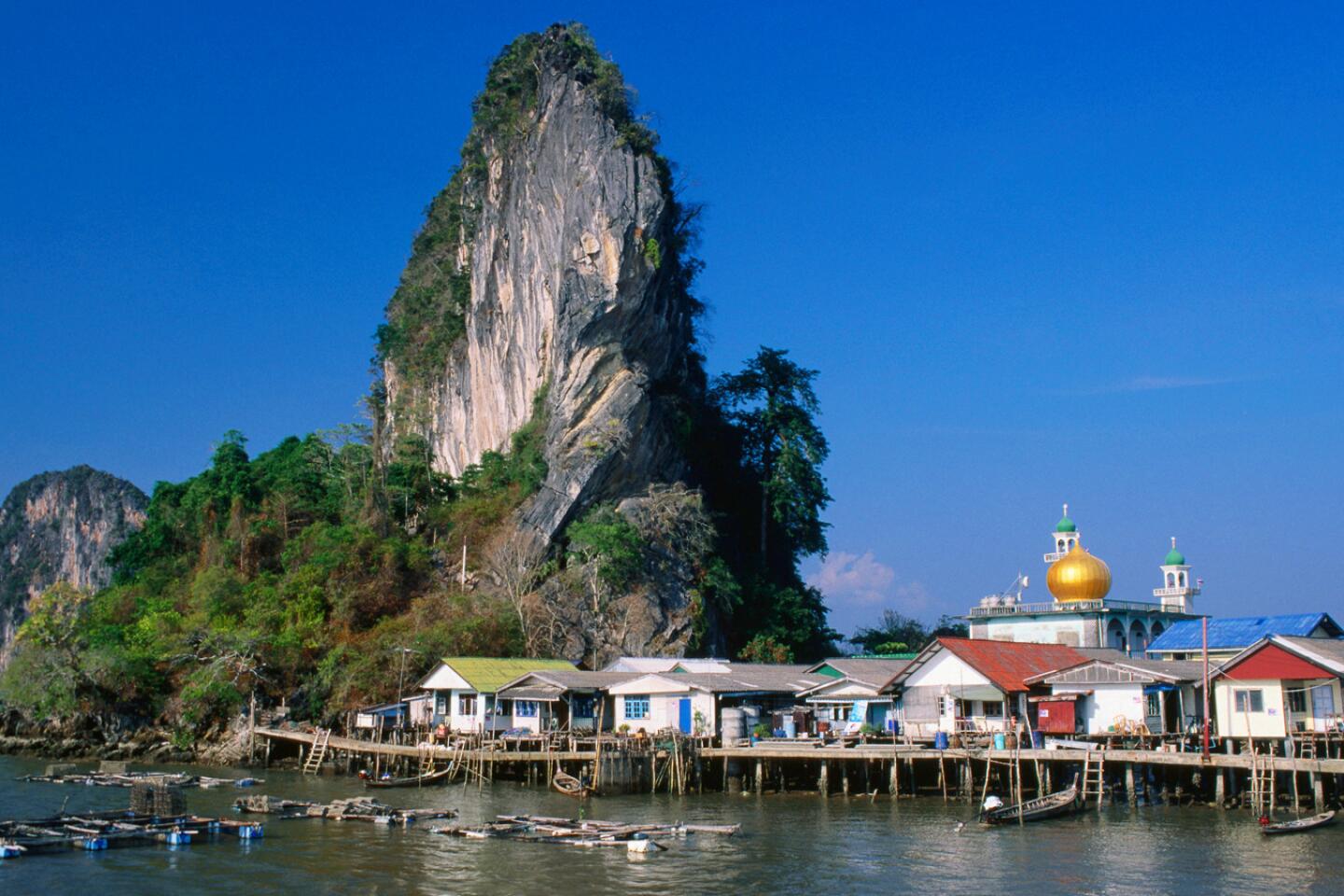The sea caves and shimmery waters of Thailand’s Phang Nga Bay mix wonder and serenity
- Share via
PHANG NGA BAY, Thailand — If you’re after calm emerald water punctuated by towering monoliths, few places compare with Thailand’s 155-square-mile Phang Nga Bay.
The unusual character of the bay, once part of the massive coral reef that covered what is now Southeast Asia, arose after millenniums of tectonic action. The result: 42 limestone karst islets and islands jutting hundreds of feet out of the water.
As our speedboat crossed the boundary of the Ao Phang Nga Marine National Park, I marveled at the shimmering water surrounding what appeared to be a prehistoric cityscape of rock spires softened by lush greenery.
Adding to the drama, troupes of macaques watched us drift by from their rock ledge hangouts.

Kayakers make their way around parts of Phang Nga Bay in Thailand.
These were the final days in Thailand for my husband, Chris, and me, a highlight of our nearly monthlong tour of Southeast Asia in December 2014. After a couple of days lazing at Layan Beach on the north end of the island of Phuket, it was time to test the waters of the Andaman Sea.
We chose Laguna Tours’ “4 in 1” full-day expedition led by Pom, who grew up in the region. With nearly 30 years at the company, who better to lead us through the mangrove forests and secret spaces that lie between Thailand’s No. 1 resort island and the mainland?
Aquatic limbo
“Your camera and your iPhone take with you,” Pom told us as we stepped onto the floating dock to meet our kayaking guide. Though he spoke little English, the guide succeeded in getting us to lie back so he could maneuver our bright yellow kayak ever so delicately through a narrow opening into the sea cave on Ko Thalu (“ko” means “island”).
Fully reclined, I watched as abstract rock formations passed overhead and the comments of other visitors echoed against the stalactites.
I’ve never been inside a sensory deprivation tank, but the peacefulness of this confined space and the gently lapping water must be the closest thing to it. For those inclined to claustrophobia, fear not; the sensation lasted but seconds.
Light poured in as guides transported clusters of aquatic limbo-ers to an otherworldly space called a hong. This interior roofless room seemed even more mysterious, thanks to its craggy cliffs and mature trees growing out of the rock.
It was barely 9 a.m., and the sun was already hitting the western walls that rose some 200 feet above us. True, we were not alone — this was the high season in Southeast Asia — yet there was a sense of solitude despite the presence of three other kayaks. The hong is accessible only by boat and only during low tide. There wasn’t much time to linger as the rising tide eventually would have made exiting impossible.

A tourist boat at Ko Khao Phing Kan, also known as James Bond Island after the 1974 filming of “The Man With the Golden Gun.”
007 was here
Once back on our speedboat, we had to travel just five minutes to Ko Phing Kan, or James Bond Island, named for the fictional British Agent 007 after the 1974 filming of “The Man With the Golden Gun.”
The small island had all the artifice of a Hollywood stage set, though its natural beauty explained why it was stuffed with tourists. Still, it was entertaining to watch people jockeying for that obligatory selfie in front of Ko Tapu, a tall, spike-shaped islet offshore that once held the solar panels that powered the laser gun of Scaramanga, Roger Moore‘s movie nemesis.
“I know Roger Moore,” Pom said with a laugh. “But he doesn’t know me.”
“I think you’re a little young to know him,” Chris countered, followed by more laughter.
By now, the midday sun was beating down hard enough to coax us into the shade provided by shops hawking giant conchs, pearl jewelry and James Bond T-shirts. More interesting and cooler, perhaps, was the nearby cave created by two mammoth limestone slabs leaning against each other. One legend said it represents lovers supporting each other — a sacred place where people come to pray for a good relationship.
Floating village
My prayers, though, were for lunch, and they were promptly answered after a short boat ride to Ko Panyi, which most guidebooks describe as a floating Muslim village.
“About 1,680 people live here,” Pom said. “This is a nomadic village and is almost 150 years old.” The 350-plus families are said to be descendants of two Muslim families from Java.
But “floating” is a misnomer. Ko Panyi is really a fishing village on stilts next to a small, rocky island. After a family-style lunch more Chinese than Thai, we walked through the maze of narrow walkways, passing a school, an aquarium and people going about daily life.
With its collection of hundred-plus-seat restaurants, tourism clearly dominates island life. But for me, the village’s allure was best appreciated from offshore. As we pulled away I glimpsed the gold domes of the mosque in relief against the tree-covered limestone pinnacles.
In the bat cave
Next up was Ko Panak, about an hour by boat, and a visit on foot to a hong. Aided by headlamps and the low tide, we entered an expansive 1,150-foot-long cave, much larger than the one on Thalu Island. Adding to the drama, Pom told us, “maybe 5 or 6 meters above your head there are thousands of bats.”
“Do they bite?” I asked.
He laughed. “No, no,” he said. “These are insect bats; they don’t like us.”
Had we visited here a few hours earlier, we would have been doing it by kayak. And though I found floating into a hong more relaxing, it was no less captivating to pass through the cave on foot and observe the water line on the mangrove roots that were about as tall as I am.
We finished the day at the white sandy beach on Naka Island, which has, according to Pom, “the best beer in the world.” It’s free, he explained. It’s tough for a near-teetotaler like me to get too excited about that prospect. The white sand, crystalline waters and frolicking macaques gave me quite enough of a buzz.
::
If you go
THE BEST WAY TO PHUKET, THAILAND
From LAX, connecting service (change of planes) to Phuket is offered on Air China, Korean, China Eastern, Asiana, Qatar, Emirates and Cathay Pacific. Restricted round-trip fares begin at $1,054, including all taxes and fees.
TELEPHONES
To call the numbers below from the U.S., dial 011 (the international dialing code), 66 (the country code for Thailand) and the local number.
FINDING A TOUR OPERATOR
We used Laguna Tours, 390/1 Moo1 Sri Soonthorn Road, Cherngtalay, Thalang, Phuket; 76-362-330, www.lagunaphuket.com/tours. Offers a variety of land and sea tours, including sunset cruises, snorkeling and kayaking. Its “four for one” tour costs about $100 per person, including hotel pick-up, lunch and snacks.
WHERE TO STAY
Anantara Layan Phuket Resort, 168 Moo 6 Layan Beach Soi 4, Thalang, Phuket; 76-317-200, phuket-layan.anantara.com. Upscale luxury hotel in a quiet setting on a private beach. Doubles from about $240 a night and up.
Baan Krating Phuket Resort, 11/3 Moo 1, Wiset Road, Rawai Ao Sane Beach, Phuket; 76-510-927, www.baankrating.com. Mid-range hotel on Phuket’s southern end; jungle-like hillside setting with ocean views. Rooms from about $70 a night.
WHERE TO EAT
Dee Plee Restaurant, deeplee.layan@anantara.com. At the Anantara resort on a hillside with sweet views. Dishes include green mango salad with Thai herbs and soft-shell crab and wok-fried flat noodles with vegetables and Korobuta pork tenderloin.
Siam Supper Club, 36/40 Lagoon Road, Choeng Thale, Phuket, 76-270-936, www.siamsupperclub.com. Atmospheric eatery on Phuket’s west coast. Features Wagyu beef carpaccio and seafood selections such as barbecued Tasmanian salmon. Pizza and pasta also available.
TO LEARN MORE
Tourism Authority of Thailand, (323) 461-9814, www.tourismthailand.org.
More to Read
Sign up for The Wild
We’ll help you find the best places to hike, bike and run, as well as the perfect silent spots for meditation and yoga.
You may occasionally receive promotional content from the Los Angeles Times.









